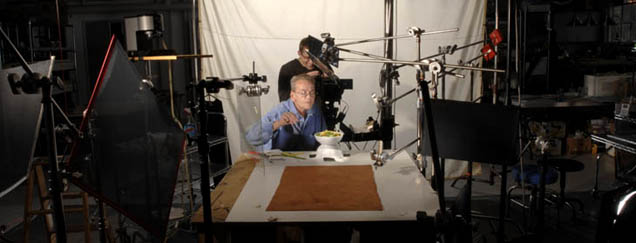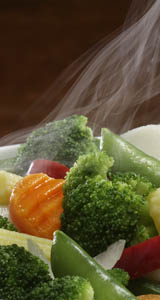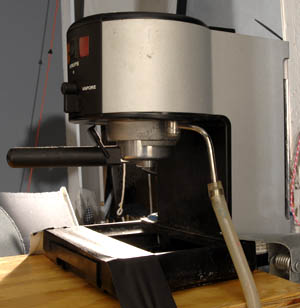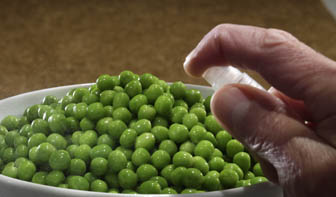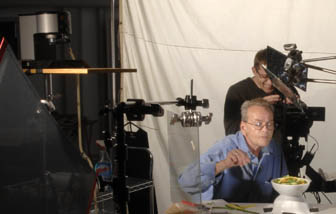Professional Food photographer gives you some tips, tricks, and techniques on how to capture steam when photographing food.I was recently on a food photography forum where the topic of the day was “what’s the hardest thing for you to photograph”. Several of the forum participants mentioned that they had a very difficult time photographing steam. Coincidently, I was in the middle of photographing a three-day steamed vegetal food-packaging shoot. Since I had just had to deal with that very problem, I thought I’d document what went into a professional food photography job where capturing steam was a very important aspect of the shoot. The images and information (tips and tricks) below are from that shoot.
|
||||
Photography Studio ConditionsOne of the toughest variables is the actual wind current in the photo studio. Even a slight draft from the heater or air conditioner will greatly affect the shape and direction of the steam. Even the slight draft created by the stylist’s arm will cause a draft that makes the steam take a particular shape. Sometimes those affects will be a positive “happy accident”, but most times they will not. Happy accident or not, the affects of all these subtle influences are seldom repeatable. In other words, if something happens that you really like, its rare that the same situation can be reconstructed so that the same effect can be captured a second time. To properly photograph steam, a photographer has to have three things: steam, a dark background, and backlight.Dark background I can’t tell you how many times I’ve been asked by Art Directors to make a steam effect on a shot that had a white background. Think about it. Steam is white AND somewhat transparent, so it makes sense (at least to a studio photographer) that you can’t make something separate that’s white from something else that’s white. Well, sometimes you can, but not steam. I’m sure you’re seen white on white portraits or shots of eggs on a white background, right? So you say, how come steam can’t separate from white when eggs can? The answer is simple. Eggs have an edge (visually), where something transparent, like steam, does not.
A lot more than you think goes into a professional food shoot. |
||||
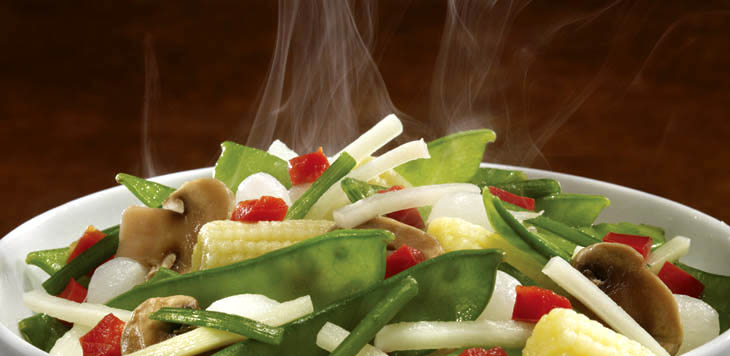
Notice how the dark background makes the steam "pop". |
||||
|
||||
|
Steam Notice that I didn’t say that you needed heat. I said you needed steam. Most amateur photographers think that the object being photographed needs to be the thing creating the steam. That is rarely the fact. Sure, sometimes it is, but most of the time it isn’t. The reason most steam is added to the shot is because it is difficult to create the desired composition quickly enough to make everyone happy and have the subject still hot enough to create steam. I most cases, the steam is made by either a steamer of some kind of smoking object like a cigarette or a “smoke cookie”. Take the corn shot (below) for example. If you think that we just dumped all that corn into a bowl hot and took a shot, you are mistaken. Each and every kernel of corn was looked at and adjusted, if it wasn’t looking just right. Notice how you can’t see up the bottom of any of the kernels. Notice how the shape of the mound of corn is almost perfect. Notice how the kernels on the side of the mound sort of poke up and make an interesting surface. All that doesn’t happen by accident. The food stylist probably sat there and poked around with a stick for over a half hour to get things just the way the Art Director wanted. Nothing will be hot after that long sitting on set. |
||||
| So what was the solution? We add steam from a steamer. Actually, the steamer was a modified cappuccino machine. The stylist blasted the corn with steam for maybe 20 seconds or so and then took away the steamer nozzle so that I could shoot it. Then we would repeat the process until we had something we liked. We probably shot 30-50 shots of each vegetable with different amounts of steam. |
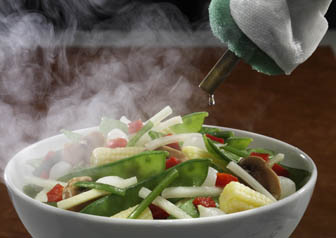 Here's the other end of the steamer |
|
||
|
See the steamer in the top left? |
There were a couple of tricks we learned as we went. One trick was that we didn’t apply the steam to the front of the bowl of corn. If we did, the steam tended to haze out the corn. And if you’re trying to sell corn, the client likes to actually show the corn :+). So we tended to apply steam to the rear and middle of the bowl. Another thing we experimented with was the length of time we applied steam to the bowl. As the steaming progressed, the corn actually started heating up and the steam would linger longer that when we first started the process. We also experimented with how broadly we applied steam over the width of the bowl. We determined that to look natural, the majority of the steam needed to come from the middle of the bowl, and not the entire width of the bowl. Another thing we determined through trial and error, that the steam needed to dissipate quite a bit to look normal. Too much steam really didn’t look very real, so if we let it settle the steam tended to loose some of the density and also some of the eddies created by the stylist withdrawing the steamer from the shot. | |||
|
||||
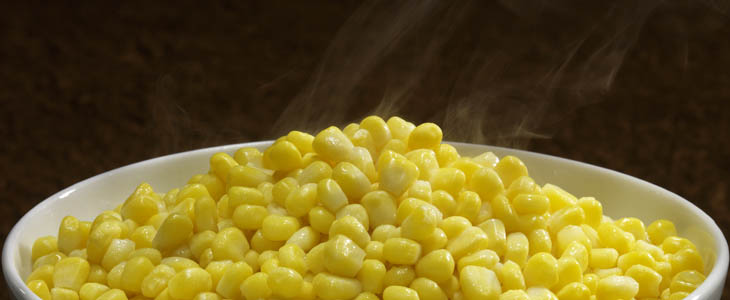
This is a shot where my "steam light" failed to go off. Notice how much of a difference a backlight makes |
||||
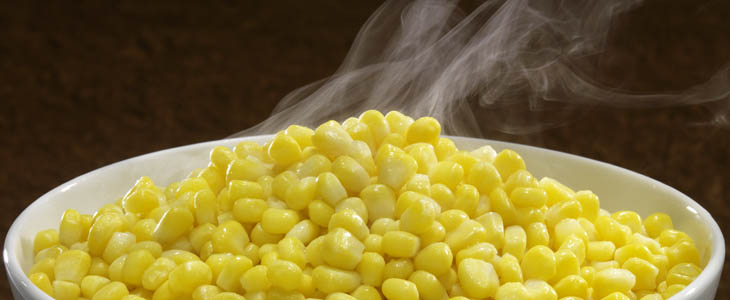
Also notice the edge light of the corn from the "steam light" |
||||
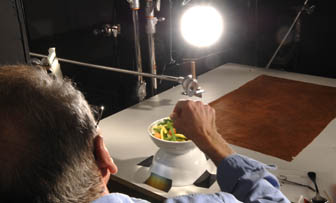 One of the three things you need to show steam, is a backlight. Notice the bright light coming from behind the set. |
How bright should you make the steam light? It’s all trial and error. Shoot and adjust. That’s one of the great things about digital photography, you can shoot and then adjust as many times as you need to without it costing you anything. In the “old days” of film, we would of need to shoot tons of Polaroids. And we would have needed to shoot probably 100 shots instead of thirty to get what we needed. With digital, you get to see what you have and then stop when you’re happy. With film, you wouldn’t know what you had until the film came back from the lab. So to make sure that you had something good, you would need to take lots and lots of shots and even then you wouldn’t be sure that you had something good. With digital, you know you have it before the shoot is over. That wasn’t the case with film. You just hoped that you had something good.
|
|||
|
|
||||
| Lighting Diagram
Here’s the basic lighting diagram from my food-packaging shoot. The main light is a 10” freznel spot light coming from 2:00, positioned relatively high so as to light into the bowl. The steam light is coming from 11:00 and is positioned low enough so that it does not affect the veggies too much. The flag is so that the steam light does not light the bowl, only the corn and steam. The mirror helps to light the side of the corn that is in the main light’s shadow. The two fill lights behind the camera are diffused by a 10’x10’ silk, to provide a “true fill” effect.
|
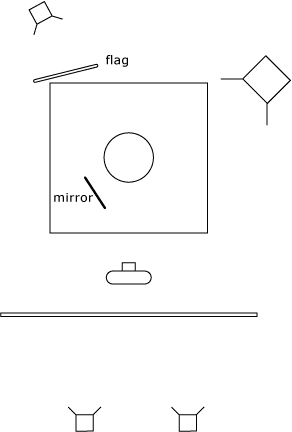 |
|
||
|
Care to join our mailing list? Return to the Food Photography Blog Didn't find what you were looking for? |
||||
.© Michael Ray 2008

